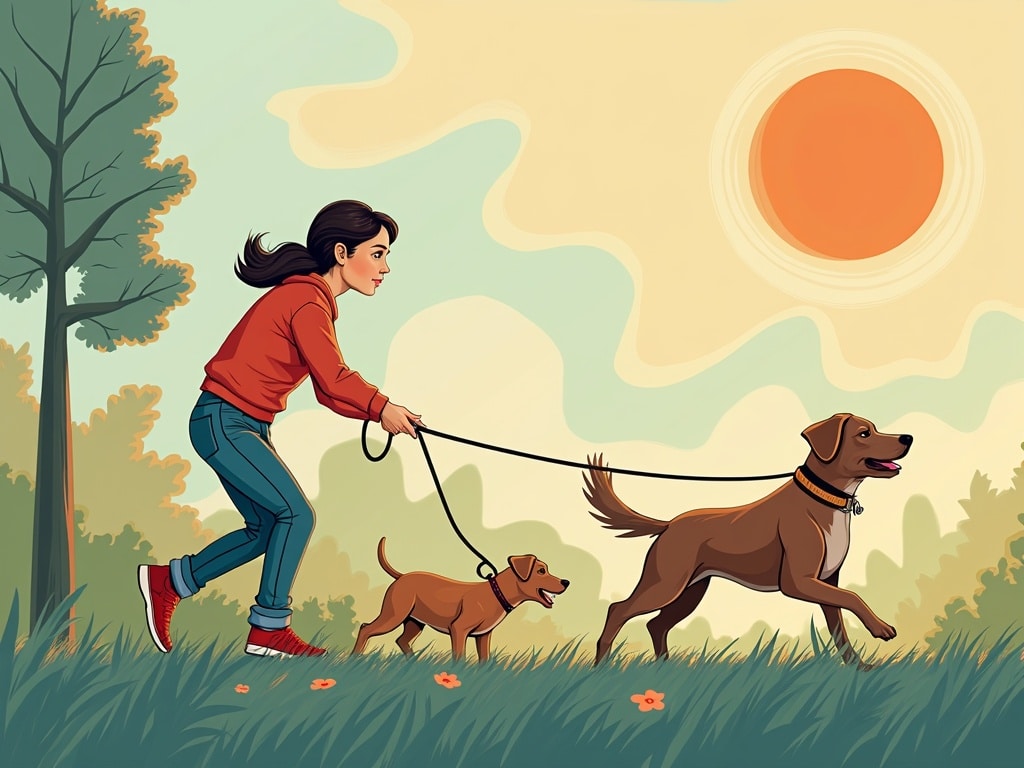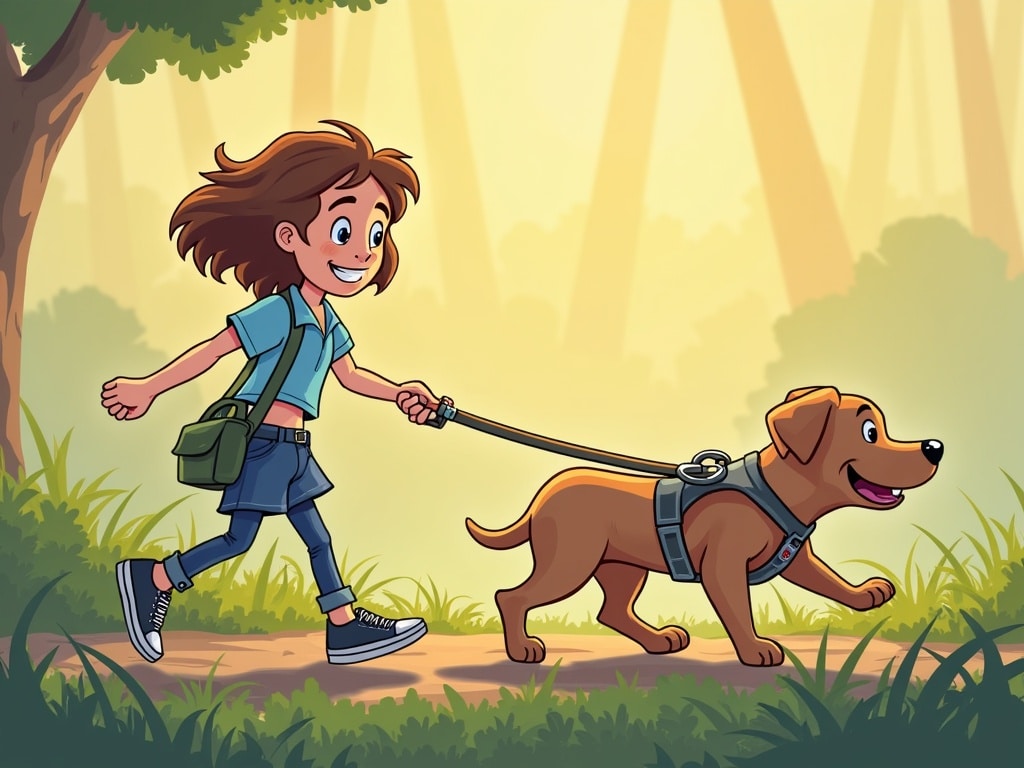The Pulling Paradox: Understanding and Correcting Your Dog's Leash Habits
Picture this: a serene morning walk, birds chirping, you’re enjoying the fresh air… and then BAM! Your dog lunges forward like a furry torpedo, leash taut, arm aching. Sound familiar? Leash pulling is one of the most common frustrations for dog owners. It transforms pleasant strolls into arm-wrenching battles and leaves both you and your canine companion stressed. But why do dogs pull, and more importantly, what dog pulling solutions actually work?
This comprehensive guide dives deep into the pulling paradox, revealing the underlying causes of this frustrating behavior and arming you with proven techniques to transform your walks from chaotic tug-of-wars into enjoyable, harmonious experiences. We'll explore everything from choosing the right equipment to mastering effective training methods, all while understanding your dog's perspective. Get ready to say goodbye to strained shoulders and hello to relaxed, enjoyable walks with your best friend.
Why Do Dogs Pull on Leash? Unraveling the Mystery
To effectively address leash pulling, it's crucial to understand its roots. Dogs pull for a variety of reasons, often stemming from their natural instincts and how we inadvertently reinforce the behavior:
- Instinct and Breed: Many breeds, especially those bred for hunting or herding, have a natural inclination to explore and follow scents. Their high energy and drive can translate into a strong pull on the leash.
- Faster is More Fun: Let's face it, dogs generally move faster than we do. Pulling allows them to reach interesting smells, greet other dogs, or explore new areas more quickly.
- The Mushing Mentality: Some dogs enjoy the physical sensation of pulling against resistance. It triggers a natural instinct, similar to sled dogs mushing in a harness.
- Lack of Training: Often, the simplest explanation is the lack of consistent training. If a dog hasn't been taught to walk nicely on a leash, they'll naturally default to pulling.
- Excitement and Frustration: A dog who is overly excited or frustrated can resort to pulling as a way to release pent-up energy or express their emotions.
- Learned Behavior: This is a big one. If, even occasionally, pulling gets your dog what they want (reaching a fire hydrant, greeting a friend), you're inadvertently reinforcing the behavior.
The Ripple Effect: Why Leash Pulling is a Problem
Leash pulling affects everyone involved, not just the owner. It's a multi-faceted problem with consequences for the dog, the owner, and even the wider community:
- For the Dog:
- Physical Discomfort: Pulling can strain the dog's neck, throat, and spine, especially if they're wearing a collar.
- Limited Exploration: When a dog pulls, they miss out on subtle smells and sights, reducing their ability to fully explore their environment.
- Increased Stress: The frustration of pulling and the potential for correction can lead to increased stress and anxiety.
- For the Owner:
- Physical Strain: Arm, shoulder, and back pain are common complaints among owners of dogs who pull.
- Reduced Enjoyment: Walks become a chore instead of a pleasure, leading to less exercise for both dog and owner.
- Embarrassment: It can be embarrassing to struggle with a dog who is constantly pulling, especially in public.
- For Others:
- Safety Concerns: A dog who pulls is more likely to lunge at other dogs, people, or objects, creating a potentially dangerous situation.
- Negative Interactions: Fearful individuals may have negative interactions with a dog with poor leash manor.
Gearing Up for Success: Choosing the Right Equipment
The equipment you use plays a significant role in your dog's comfort and your ability to control them. The harness vs. collar debate is an important one, with each having its pros and cons for dog pulling solutions:
- Collars:
- Pros: Can be useful for ID tags and can be effective for dogs who respond well to gentle pressure.
- Cons: Can cause neck injuries and trachea damage if a dog pulls excessively. Avoid choke chains and prong collars, as they can be harmful and inhumane.
- Harnesses:
- Pros: Distribute pressure more evenly across the dog's chest and back, reducing the risk of injury. Front-clip harnesses can be particularly effective in discouraging pulling.
- Cons: Some dogs may still pull in a harness, although it's generally safer than pulling in a collar.
Leash Types:
- Standard Leashes (4-6 feet): Ideal for training and providing control.
- Retractable Leashes: Discouraged for training, as they teach dogs that pulling extends the leash and allows them to go further. This reinforces the pulling behavior.
- Long Lines (15-30 feet): Useful for off-leash training in safe, enclosed areas, but not recommended for everyday walks if your dog pulls.
Consider reading Pet Proofing Your House: A Dog Owner's Guide to a Safe Haven.
Building a Foundation: Basic Training Techniques for Loose-Leash Walking
The cornerstone of effective leash training is positive reinforcement. This means rewarding your dog for good behavior (walking nicely on a loose leash) and avoiding punishment for pulling. Remember, the goal is to create a positive association with walking on a leash:
- Treats, Praise, and Toys: Find what motivates your dog and use it as a reward. High-value treats (small, smelly, and delicious) are particularly effective.
- Marker Training (Clicker Training): A clicker can be a valuable tool for marking the exact moment your dog performs the desired behavior (walking with a loose leash). The click is always followed by a reward.
- Consistency is Key: Use the same cues and commands consistently, and practice in short, frequent sessions.
- Patience, Patience, Patience: Leash training takes time and patience. Don't get discouraged if you don't see results immediately.
Step-by-Step Guide to Teaching Loose-Leash Walking
Here's a detailed step-by-step guide to help you teach your dog to walk nicely on a leash and effective dog pulling solutions:
- Start Indoors: Practice walking with your dog on a leash indoors, in a low-distraction environment. Reward them for staying close to you.
- Introduce the Leash: Let your dog wear the leash and harness/collar for short periods indoors, so they get used to it.
- Luring with Treats: Hold a treat near your leg and lure your dog into a heel position (close to your side). Reward them as they walk with you.
- Short Walks in a Quiet Area: Once your dog is comfortable walking with you indoors, move to a quiet outdoor area with minimal distractions.
- The Red Light, Green Light Game:
- Start walking. If your dog starts to pull, stop immediately.
- Wait for your dog to stop pulling and for the leash to become loose.
- Reward your dog for the loose leash.
- Start walking again. Repeat the process every time your dog pulls.
- Change Direction: If your dog starts to pull, change direction abruptly. This will encourage them to pay attention to you and follow your lead.
- Gradually Increase Distance and Distractions: As your dog improves, gradually increase the distance of your walks and introduce more distractions.
Avoiding Common Pitfalls: Mistakes to Steer Clear Of
Even with the best intentions, it's easy to make mistakes during leash training. Here are some common pitfalls to avoid:
- Inconsistency: Not consistently applying the training techniques will confuse your dog and slow down their progress.
- Punishment: Yelling, jerking the leash, or using other forms of punishment will create a negative association with walks.
- Letting Them Get Away With Pulling: Even occasionally allowing your dog to pull you to something they want will reinforce the pulling behavior.
- Too Much, Too Soon: Progressing too quickly to more challenging environments before your dog is ready can lead to frustration and setbacks.
- Using the Wrong Equipment: Retractable leashes and prong collars are generally not recommended for leash training.
Navigating the Real World: Dealing with Distractions
Distractions are inevitable, especially in stimulating environments. Here's how to handle them effectively:
- Be Prepared: Anticipate potential distractions (other dogs, squirrels, etc.) and have treats ready.
- Increase the Value of Your Reinforcement: Use higher-value treats when distractions are present.
- Create Distance: If possible, increase the distance between your dog and the distraction.
- Engage Your Dog: Use commands like look at me or touch to redirect their attention back to you.
- Reward for Ignoring Distractions: Reward your dog for remaining calm and focused on you in the presence of distractions.
Addressing Specific Pulling Triggers
Many dogs pull towards specific things, such as other dogs, squirrels, or interesting smells. Here's how to address these specific triggers:
- Pulling Towards Other Dogs:
- Socialization: Ensure your dog has adequate socialization opportunities.
- Controlled Greetings: Teach your dog to greet other dogs calmly and politely, on a loose leash.
- Distance and Desensitization: Gradually expose your dog to other dogs from a distance, rewarding them for remaining calm.
- Pulling Towards Squirrels or Other Animals:
- Leave It Command: Teach your dog the leave it command and use it to redirect their attention away from the animal.
- High-Value Rewards: Use extremely high-value rewards to make you more interesting than the animal.
- Management: Avoid areas with a high concentration of squirrels or other animals until your dog is better trained.
- Sniffing everything:
- https://riverscorner.net/blogs/news/stop-the-tug-of-war-secrets-to-a-relaxed-leash-experience is a great external resource.
When to Call in the Pros: Seeking Expert Help
If you're struggling to make progress with leash training, or if your dog's pulling is severe or accompanied by other behavioral issues, it's time to seek professional help from a certified dog trainer or behaviorist. They can provide personalized guidance and address any underlying issues that may be contributing to the pulling behavior.
The Long Game: Maintaining Loose-Leash Walking Habits
Once you've achieved loose-leash walking, the work isn't over. Maintaining these habits requires ongoing consistency and reinforcement:
- Continue Practicing: Regularly practice loose-leash walking, even after your dog has mastered it.
- Reinforce Good Behavior: Continue to reward your dog for walking nicely on a leash.
- Be Consistent: Enforce the rules consistently, and don't let your dog get away with pulling, even occasionally.
- Vary Routes and Environments: Continue to expose your dog to different environments and distractions to keep them engaged and challenged.
The Takeaway: A Lifetime of Enjoyable Walks
Conquering the pulling paradox isn't just about achieving a more relaxed walk; it's about building a stronger bond with your dog and enriching their lives. By understanding the reasons behind pulling, choosing the right equipment, and employing positive reinforcement techniques, you can transform your walks from frustrating battles into joyful explorations for both you and your beloved companion. Remember, consistency, patience, and a deep understanding of your dog are the keys to unlocking a lifetime of enjoyable, pull-free walks and effective dog pulling solutions.


